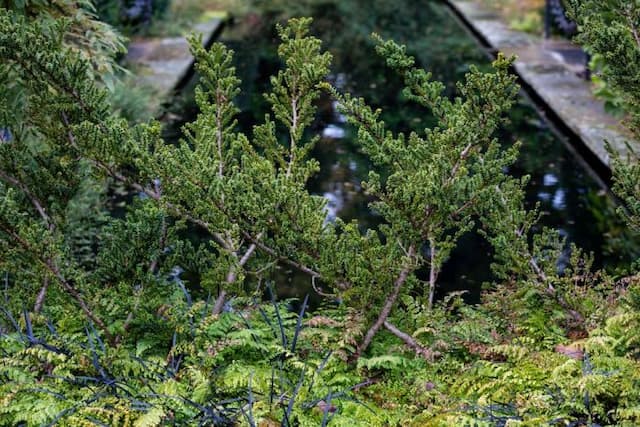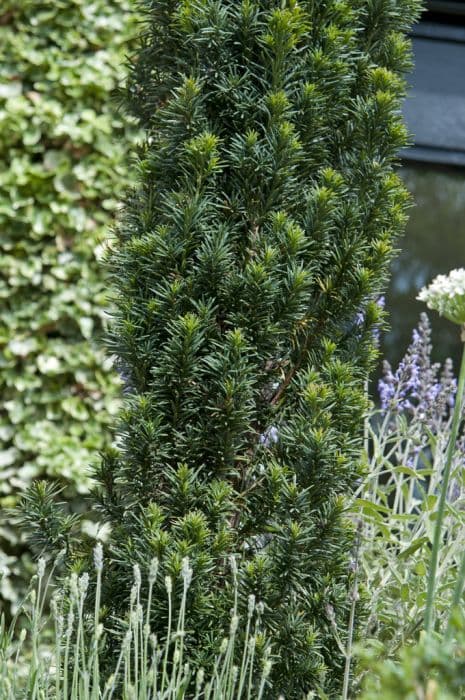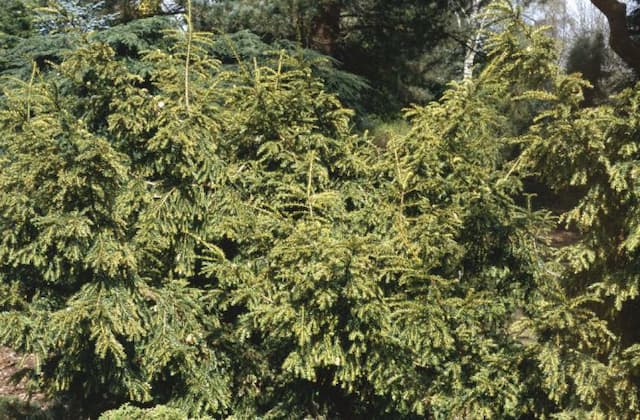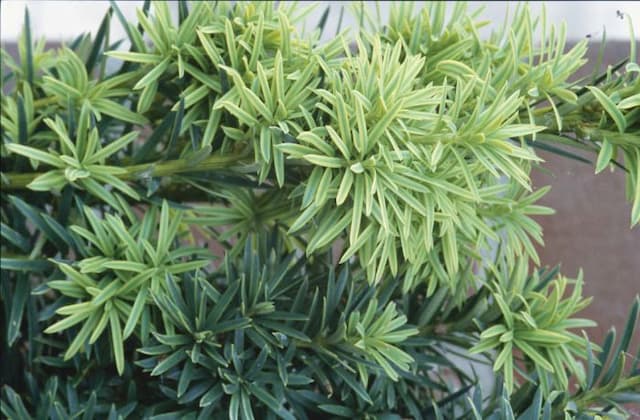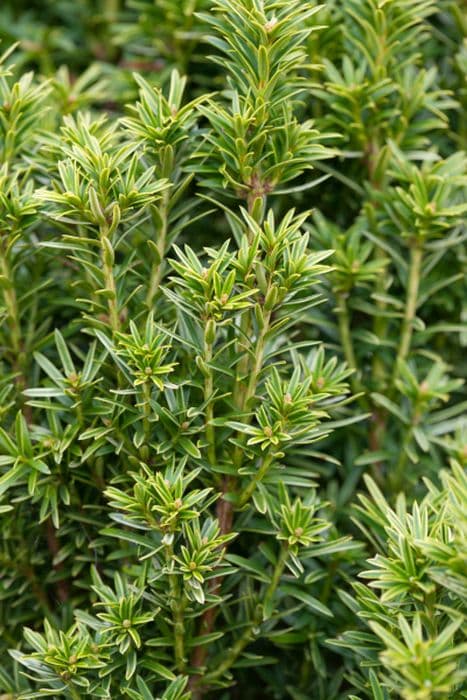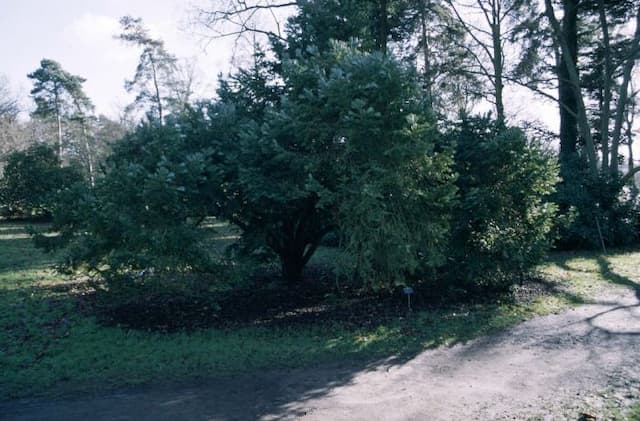Irish Yew Taxus baccata 'Standishii' (f)

ABOUT
Taxus baccata 'Standishii', commonly known as the English yew 'Standishii', is a distinctive plant with a unique appearance. It is an evergreen, meaning it retains its leaves throughout the year. The foliage of 'Standishii' is characterized by its bright golden-yellow needles, which are narrow, smooth, and have a slightly curved shape. The contrast of the yellow foliage against the darker green needles that are more typical of English yews is particularly striking when the plant is viewed with new growth in the spring. The needles are arranged in two flat rows on either side of the stems, creating a somewhat fern-like appearance. These elegant stems branch gracefully and form a dense, bushy habit that can be manicured into various shapes if desired, lending itself well to formal garden settings. In addition to its beautiful foliage, 'Standishii' also produces small, inconspicuous flowers, which are followed by red berry-like structures called arils. These arils are a hallmark of the yew; however, they contain a hard seed at their center. It's important to note that while the arils are attractive, particularly against the plant's striking foliage, all parts of the English yew, excluding the flesh of the arils, are poisonous and should not be ingested. The plant's bark is another subtle feature, being reddish-brown and developing a rough, flaky texture with age. This provides an interesting contrast to the more vibrant aspects of its foliage and fruit. Overall, the English yew 'Standishii' has a unique and sculptural form accentuated by its golden needles and red berries, making it a standout specimen in any garden it graces. Its evergreen nature ensures that it provides color and interest throughout all seasons.
About this plant
 Names
NamesSynonyms
Standish Yew, Irish Yew
Common names
Taxus baccata 'Standishii' (f).
 Toxicity
ToxicityTo humans
The English yew is highly toxic to humans. Ingesting any part of the plant, especially the seeds, can lead to severe poisoning. The symptoms of English yew poisoning include dizziness, dry mouth, dilation of the pupils, weakness, and irregular heart rhythm which can potentially be fatal. If ingested, it can also cause gastrointestinal distress and convulsions.
To pets
The English yew is also highly toxic to pets. The entire plant, apart from the flesh of the berry, contains dangerous compounds that can result in poisoning if ingested. Symptoms of poisoning in pets may include vomiting, diarrhea, difficulty breathing, tremors, weakness, life-threatening changes in heart rate, and potential heart failure. English yew poisoning can be fatal to pets and requires immediate veterinary attention.
 Characteristics
CharacteristicsLife cycle
Perennials
Foliage type
Evergreen
Color of leaves
Green
Height
6 feet (1.83 meters)
Spread
2 feet (0.61 meters)
Plant type
Shrub
Hardiness zones
7
Native area
Europe
Benefits
 General Benefits
General Benefits- Aesthetic Appeal: Provides visual interest with its bright, variegated foliage and columnar growth habit.
- Low Maintenance: Requires minimal care once established, with infrequent watering and pruning needs.
- Drought Tolerant: Can survive in dry conditions, making it suitable for water-conservation landscapes.
- Cold Hardy: Resilient in cold weather and can withstand frost, making it suitable for a variety of climates.
- Evergreen: Retains its foliage year-round, providing constant color and structure to the garden.
- Wildlife Support: Produces seeds that can serve as food for birds, and offers shelter for various wildlife.
- Privacy Screen: With its dense growth, it can be used as a natural privacy screen or hedge.
- Soil Erosion Control: Its root system can help stabilize soil and prevent erosion.
- Architectural Plant: Can be used to create formal designs in gardens due to its distinct shape and texture.
 Medical Properties
Medical Properties- Contains taxanes: Taxus baccata, commonly known as English yew or simply yew, contains compounds known as taxanes that are used in cancer treatment, particularly paclitaxel which is used in chemotherapy.
- Antimitotic activity: The taxanes in yew act to stabilize tubulin polymers, preventing their disassembly and thereby inhibiting cell division, a mechanism utilized in cancer treatment.
 Air-purifying Qualities
Air-purifying QualitiesThis plant is not specifically known for air purifying qualities.
 Other Uses
Other Uses- Taxus baccata 'Standishii', also known as the Irish Yew, has been historically used to craft longbows due to its flexibility and strength.
- Woodturners value the wood of the Irish Yew for its fine grain, which can be polished to a high sheen for decorative objects such as bowls and vases.
- Irish Yew is often planted in gardens and parks as an ornamental tree, particularly appreciated for its slender, columnar form.
- The dense foliage of the Irish Yew provides excellent cover for birds, making it an ideal choice for wildlife gardens.
- In landscaping, its columnar shape is used to create striking hedges and topiaries.
- Furniture makers occasionally use Irish Yew wood for high-quality furniture pieces due to its rich, reddish color and durability.
- Irish Yew can be used in bonsai culture, where its evergreen nature and adaptability to pruning make it an interesting species for miniature tree art.
- Its berries (arils), while toxic to humans, can be used to create dyes for textiles once they are processed correctly to remove toxins.
- Irish Yew branches are sometimes used in floral arrangements, particularly in winter, when the contrast of red berries and dark green foliage is striking.
- The tree is sometimes planted in cemeteries, symbolizing both mourning and eternal life due to its evergreen nature and long lifespan.
Interesting Facts
 Feng Shui
Feng ShuiThe English Yew is not used in Feng Shui practice.
 Zodiac Sign Compitability
Zodiac Sign CompitabilityThe English Yew is not used in astrology practice.
 Plant Symbolism
Plant Symbolism- Eternity: The Taxus baccata, commonly known as the Yew tree, is long-lived, symbolizing immortality and everlasting life.
- Resilience: Yew trees are known for their ability to withstand harsh conditions, representing endurance and the ability to persevere.
- Transformation: Due to its association with old age and its long life cycle, the Yew tree reflects the idea of death leading to rebirth, and thus transformation.
- Protection: In ancient times, Yew wood was used to make bows and for defensive purposes, symbolizing protection and defense against adversaries.
- Sacredness: Yews are often found in churchyards in Britain and other parts of Europe, indicating the tree's association with the sacred and the divine.
 Water
WaterThe Irish Yew requires regular watering to maintain moist but not waterlogged soil, especially during dry periods. Initially, water newly planted Irish Yews deeply with around 2-3 gallons of water weekly. Once established, reduce watering to about every 2-3 weeks, depending on the weather conditions. During hot or windy weather, more frequent watering may be necessary to prevent drying out. Always check the soil moisture at about 2-3 inches depth; if the soil feels dry at that level, it's time to water again.
 Light
LightIrish Yews prefer to be positioned in a location with partial to full sun exposure. They thrive when they receive morning sunlight and some afternoon shade, especially in hotter climates. However, they can adapt to full sun conditions when acclimated gradually. Avoid deep shade, as this can hinder the growth and density of the yew's foliage.
 Temperature
TemperatureIrish Yews are hardy and can tolerate a wide range of temperatures but prefer a temperate climate. They can endure winter lows down to 20°F but perform best in environments where temperatures range between 60°F and 70°F. Extremes of heat and cold beyond these thresholds may stress the plant, but Irish Yews are generally resilient and can survive brief periods outside their ideal temperature range.
 Pruning
PruningPruning the Irish Yew should be done to maintain its shape, remove dead or damaged branches, and promote dense growth. Prune in late winter or early spring before new growth begins. Light trimming can be carried out again in mid-summer if needed to tidy up new growth. It is not recommended to prune heavily, as yews can be slow to recover from aggressive pruning.
 Cleaning
CleaningAs needed
 Soil
SoilEnglish Yew 'Standishii' prefers well-draining soil rich in organic matter with a pH ranging from 5.5 to 7.5. A mix of loam, peat moss, and perlite or sand ensures proper aeration and drainage, which is vital for the health of the roots and prevention of root rot.
 Repotting
RepottingEnglish Yew 'Standishii' should be repotted every 3 to 5 years or when it outgrows its current container, as they are slow-growing plants. Choose a pot just one size larger to prevent over-potting which can lead to excess soil moisture and root rot.
 Humidity & Misting
Humidity & MistingEnglish Yew 'Standishii' is quite adaptable and can tolerate a range of humidity levels but thrives best in moderate humidity about 40-60%. Protect it from drying winds and avoid placing it in excessively arid environments.
 Suitable locations
Suitable locationsIndoor
Place English Yew 'Standishii' in bright, indirect light; water sparingly.
Outdoor
Plant in partial shade, shelter from strong winds, well-draining soil.
Hardiness zone
6-7 USDA
 Life cycle
Life cycleTaxus baccata 'Standishii', commonly known as the Standish Yew, begins its life cycle when seeds are dispersed from the fleshy aril and germinate in suitable conditions, often requiring stratification to break dormancy. The seedlings grow slowly, developing a deep taproot and in time, establish a woody stem and a conical growth habit characteristic of young yews. As the Standish Yew matures, it forms dense, upright branches with bright green needles and, being dioecious, female plants produce red arils enclosing the seeds after pollination by wind-borne pollen from male plants. Over many years, the Standish Yew can evolve into a substantial, bushy tree, reaching up to 6 meters in height. It is a long-lived species, with individual plants capable of surviving for centuries under favorable conditions. In the final stage of its life cycle, the Standish Yew eventually declines in vigor and health, susceptible to environmental stresses and pathogens, until it dies and decomposes, returning nutrients to the soil and potentially giving rise to new yew saplings.
 Propogation
PropogationPropogation time
Late Winter
Propogation: The English yew 'Standishii' is commonly propagated by cuttings, a practice best done in late summer to early fall, allowing the cuttings to establish roots prior to the onset of cold weather. To propagate by cuttings, one would select healthy, semi-hardwood stems from the current year's growth. A length of about 4 to 6 inches (10 to 15 centimeters) is ideal, and the lower needles should be removed. The cut end of the cutting can be dipped in rooting hormone to enhance root development and then planted in a well-draining rooting medium kept moist but not soggy. To maintain a high humidity environment, which aids in preventing the cutting from drying out before roots can form, it is beneficial to cover it with a plastic bag or use a propagator. Roots typically form within a few months, after which the new plants can be potted on or eventually planted out.
